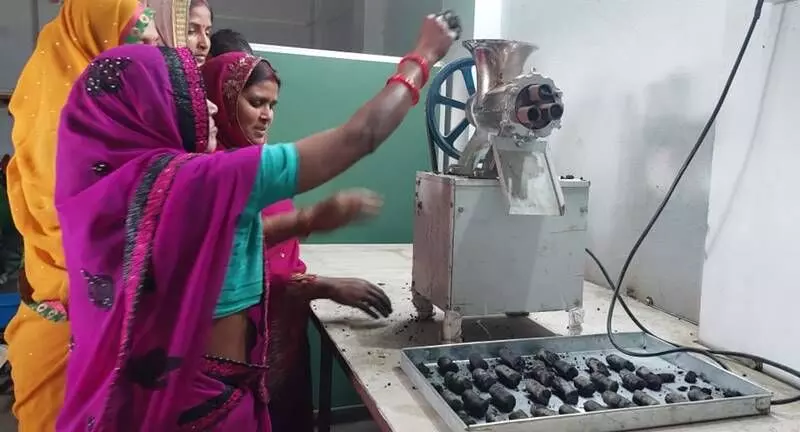Ashrafpur (Sitapur), Uttar Pradesh
When the cost of essential commodities rose alarmingly, 34-year-old Anita Devi realised that she had to do something to augment the family income.
A resident of Ashrafpur village in Uttar Pradesh’s Sitapur district, the mother of two told Gaon Connection that she was trained at the agriculture department’s Krishi Vigyan Kendra (Farmers’ Science Centre) at Katia, which was 15 kilometres from her home. But, it helped her contribute to her household income.
“I learnt how to make pradooshan rahit (pollution-free) raakh ki pindi (ash briquettes) from the crop residue. The officials at the kendra taught me, and now my group earns three hundred to five hundred rupees a day,” she told Gaon Connection. Her batch consists of 10 women who work for about two hours a day making these briquettes.
Apart from Anita Devi’s self-help group, 20 more women have been trained by Krishi Vigyan Kendra (KVK) in Katia, about 100 kilometres from the state capital Lucknow. These rural women collect crop stubble from the fields, convert them into fuel pellets and sell locally to eateries and hotels at a rate of Rs 35 per kilogramme. Since it is the wedding season, these agricultural waste briquettes, which are used as cooking fuel, are in high demand, informed the women.
“These 30 women were trained for 15 days in the second half of January. Now, we have formed three groups of 10 women each and provided these groups with a free-of-cost burner which converts stubble into ash. The women spend almost two hours making briquettes in a day,” Anand Singh, scientist at the KVK, told Gaon Connection.
According to him, there were plans to train more women from the nearby villages, as it will not only provide livelihood to the local women but also address the issue of crop residue and stubble burning in the fields, which causes air pollution.
Smokeless, cheaper and empowering
“Farmers generally burn the residue and add to the already bad air quality. But with our technique, the smoke-less fuel produced can at least reduce the dependency on coal which is another pollutant which contributes to air pollution,” Singh said.
The scientist also pointed out that a majority of women in the rural hinterland are still using a choolha (a woodfired stove) to cook and by using this eco-friendly product can lower the indoor air pollution as well.

Since it is the wedding season, these agricultural waste briquettes, which are used as cooking fuel, are in high demand, informed the women.
“It is cost-effective. A kilogram of coal is generally required to cook a meal for four people. However, only about two hundred and fifty grams of the smokeless biofuel does the same job, and it costs around eight to ten rupees. It takes about ten kilogrammes of residue to produce a kilogram of this biofuel,” Singh added.
Phool Kumari, one of the 30 women trained to convert the stubble into biofuel, told how it had become a struggle to run a household.
“I cannot read or write. I don’t want my children to suffer the same fate. With this rising mehengayi (inflation), it was becoming difficult to take care of the household and provide nutritious food to my children. But now I know how to produce something and earn by selling it. It means a lot to poor families like ours,” Kumari, a resident of Lodhaura village in Piswa block of Sitapur added.
Savitri, another woman from the same village who received the training stated that not depending on her husband’s income has added to her confidence.
“Even if my husband is unable to earn in a month, selling these koyla (briquettes) gets me enough money to meet the household expenses. I feel confident that I am self-reliant,” she said.
Making eco-friendly ‘briquettes’ from stubble
Anand Singh explained that in order to produce biofuel from the crop residue, it is put into a burner and turned into ash.
“The burner has a chimney to ensure that the working environment remains pollution-free. We then prepare a dough with wheat flour and mix in the soot. The mixture is then dried and is ready for use. It burns better than coal and is a lot cheaper. A lot of dhabas (eateries) in the area buy this fuel from the rural women,” he said.
The making of the briquettes also meant that it brought down the workload for the rural women. “Collecting firewood is a tedious task and the smoke the burning wood emits is a hazard for millions of women. If this process is adopted on a larger scale, I am sure it can bring about a social transformation,” he added.

These rural women collect crop stubble from the fields, convert them into fuel pellets and sell locally to eateries and hotels at a rate of Rs 35 per kilogramme.
The official informed Gaon Connection that after the election results are declared (i.e. after March 10), efforts will be made to ensure that the trained women are helped with setting up a self-help group (SHG) to run a more efficient and coordinated enterprise.
“The briquettes made by these women are getting a good response from the market. If applied on a larger scale, it can become a successful model of empowering women in the rural areas. We are working on expanding the initiative to more districts,” he said.


















